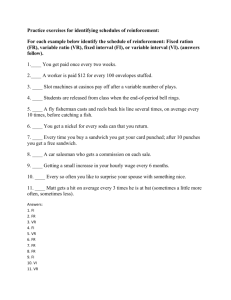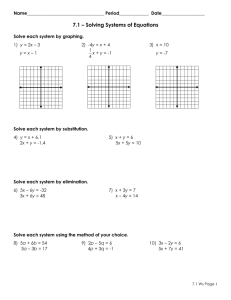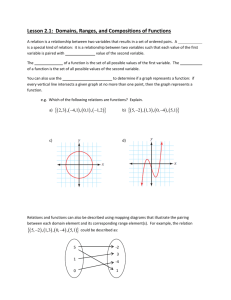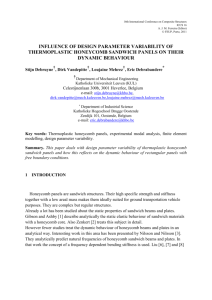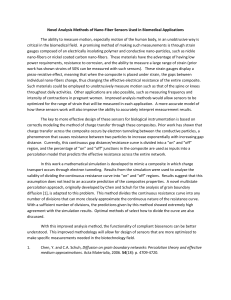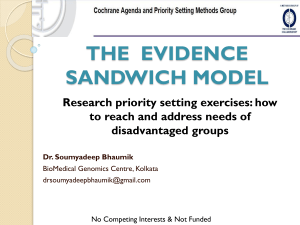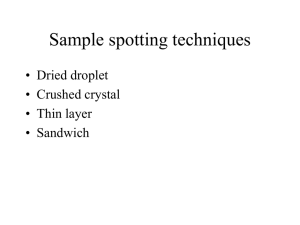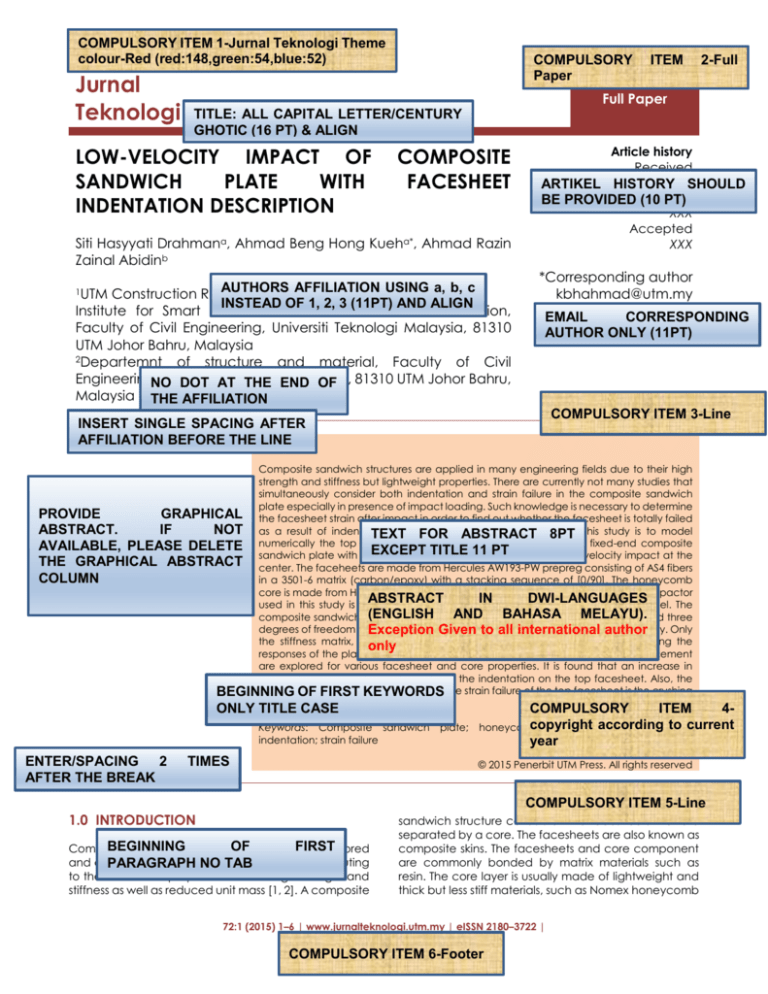
COMPULSORY ITEM 1-Jurnal Teknologi Theme
colour-Red (red:148,green:54,blue:52)
Jurnal
Teknologi
COMPULSORY
Paper
ITEM
2-Full
Full Paper
TITLE: ALL CAPITAL LETTER/CENTURY
GHOTIC (16 PT) & ALIGN
LOW-VELOCITY IMPACT OF
SANDWICH
PLATE
WITH
INDENTATION DESCRIPTION
COMPOSITE
FACESHEET
Siti Hasyyati Drahmana, Ahmad Beng Hong Kueha*, Ahmad Razin
Zainal Abidinb
AUTHORS
AFFILIATION
USING a, b, c
Construction Research
Centre
(CRC),
INSTEAD OF 1, 2, 3 (11PT) AND ALIGN
Institute for Smart Infrastructure and Innovative Construction,
Faculty of Civil Engineering, Universiti Teknologi Malaysia, 81310
UTM Johor Bahru, Malaysia
2Departemnt
of structure and material, Faculty of Civil
Engineering,
Universiti
Teknologi
Malaysia,
NO DOT AT
THE END
OF 81310 UTM Johor Bahru,
Malaysia THE AFFILIATION
1UTM
Article history
Received
ARTIKEL HISTORYXXXSHOULD
Received
in revised
form
BE
PROVIDED
(10 PT)
XXX
Accepted
XXX
*Corresponding author
kbhahmad@utm.my
EMAIL
CORRESPONDING
AUTHOR ONLY (11PT)
COMPULSORY ITEM 3-Line
INSERT SINGLE SPACING AFTER
AFFILIATION
LINE
Graphical BEFORE
abstract THE Abstract
Composite sandwich structures are applied in many engineering fields due to their high
strength and stiffness but lightweight properties. There are currently not many studies that
simultaneously consider both indentation and strain failure in the composite sandwich
plate especially in presence of impact loading. Such knowledge is necessary to determine
PROVIDE
GRAPHICAL the facesheet strain after impact in order to find out whether the facesheet is totally failed
ABSTRACT.
IF
NOT as a result of indentation
deformation.
Hence, the purpose
TEXT
FOR ABSTRACT
8PTof this study is to model
indentation and strain failure of a fixed-end composite
AVAILABLE, PLEASE DELETE numerically the top facesheet
EXCEPTcore
TITLE
sandwich plate with honeycomb
when11
it isPT
subjected to low-velocity impact at the
THE GRAPHICAL ABSTRACT center. The faceheets are made from Hercules AW193-PW prepreg consisting of AS4 fibers
COLUMN
in a 3501-6 matrix (carbon/epoxy) with a stacking sequence of [0/90]. The honeycomb
core is made from HRH 10 1/8-3.0 Nomex honeycomb (Ciba-Geigy). Type of the impactor
ABSTRACT
IN
DWI-LANGUAGES
used in this study is flat-ended cylinder, which is made from case-hardened steel. The
(ENGLISH
AND
BAHASAproblem
MELAYU).
composite sandwich plate
is modeled as
a two-dimensional
with five and three
degrees of freedom per
node for the Given
facesheets
core,author
respectively. Only
Exception
to and
all honeycomb
international
the stiffness matrix, [K], and the mass matrix, [M], are considered in determining the
only
responses of the plate. Responses in terms of indentation, strain failure and displacement
are explored for various facesheet and core properties. It is found that an increase in
number of ply and ply thickness reduce the indentation on the top facesheet. Also, the
most effective
parameter
in improving the strain failure of the top facesheet is the crushing
BEGINNING
OF FIRST
KEYWORDS
resistance of the core.
ONLY TITLE CASE
COMPULSORY
Keywords: Composite sandwich
indentation; strain failure
ENTER/SPACING 2
AFTER THE BREAK
TIMES
plate;
ITEM
year
© 2015 Penerbit UTM Press. All rights reserved
COMPULSORY ITEM 5-Line
1.0 INTRODUCTION
BEGINNING
OF are widely
FIRST
Composite
sandwich structures
explored
and applied
in numerous
engineering
fields, attributing
PARAGRAPH
NO
TAB
to their favorable properties such as high strength and
stiffness as well as reduced unit mass [1, 2]. A composite
4-
copyright
according
to current
honeycomb
core; low-velocity
impact;
sandwich structure consists of two facesheets that are
separated by a core. The facesheets are also known as
composite skins. The facesheets and core component
are commonly bonded by matrix materials such as
resin. The core layer is usually made of lightweight and
thick but less stiff materials, such as Nomex honeycomb
72:1 (2015) 1–6 | www.jurnalteknologi.utm.my | eISSN 2180–3722 |
COMPULSORY ITEM 6-Footer
2
COMPULSORY ITEM 7-Header
Drahman et al. / Jurnal Teknologi (Sciences & Engineering) 72:1 (2015) 1–7
cores, fiberglass reinforced thermoplastic, aluminum
found to be more accurate by implementing the
and foam-type cores. The top and bottom facesheets
combination of energy-balanced approach and
are commonly thin but stiff material from light alloys,
impulse-momentum equation. Williamson and Lagace
e.g., aluminum and fiber-reinforced composites [3].
[8] experimentally studied the responses of honeycomb
BEGINNING
OF
SECOND
The composite
sandwich structure
may
expose to
sandwich panels under impact loading. The experiment
several impact
loading such
as low-velocity
impact,
was performed using static indentation tests. Two
PARAGRAPH
INSERT
TAB
high-velocity
impact,
repeated
impact,
etc.
boundary conditions were considered in this study; fully
Indentation can occur during construction and
backed and two-sided clamped. The indenter shape
maintenance of the structure. For example, the
was hemispherical-nose tups or cylinder. It was found
composite sandwich structure may experience
that the top facesheet was damaged first before the
indentation due to the low-velocity impacts of tools
core. The core was damaged after the penetration
drop, machineries mishandling, heavy materials falls
took place on the top facesheet. In addition, for the
and so on [4].
two-sided clamped composite sandwich panels, the
Thanks to many attractive structure properties, the
bottom facesheet was not damaged before the failure
use of composite sandwich structure is very beneficial
of both top facesheet and core because of low strain
in engineering field especially in civil, marine, aircraft
after impact. Hoo Fatt and Park [9] studied composite
and aerospace industries. As a product, its application
sandwich panels, with symmetric orthotropic laminated
helps in terms of cost effectiveness and environmental
facesheets and core that has a constant crushing
friendliness. For example, a vehicle fabricated from
resistance, subjected to low-velocity impact. They
lightweight structures will require less energy to move
found that initial damage mode that would occur after
and indirectly consume less fuel. This means that the use
impact was influenced by boundary conditions, type of
TEXT
FOR CONTENT
CENTURY GHOTIC
of lightweight vehicle will reduce
environmental
impact9 PTimpactor/indenter
as well as geometric and material
as well as service cost of the vehicle. In construction
properties of both facesheets and core. Also, the
field, the application of composite sandwich
results from this study showed good
1. et structure
al. inside textpredicted
should be italic
is widely used in the lightweight construction.
compatibility with the experimental results from previous
Figures
and Tables
be stated
text
Thus far, there are many 2.
studies
regarding
the should
studies.
Ju et in
al.the
[10]
analyzed numerically the shear
modeling of composite 3.
sandwich
plateFigure
and and
its Tables
behaviors
of different
configurations for
Numbering
should follow
Figurehoneycomb
1,2
analyses. One of the researches was performed by
two types of materials; mild-steel and polycarbonate.
or 3 instead of Figure 2.1, 2.3 etc
Meidell [5], which investigates the sandwich beams with
The single layer design and the angle with higher
4. Ref.
inside theweight
text [1], [2]negative
should bedegrees
in normal
honeycomb core by considering
the minimum
of text
honeycomb displayed better
design. In this paper, the constitutive core equations
results.
By
using
finite
element
method, Abo Sabah and
instead of superscript
were formulated. The core formulation was found with
Kueh [11] carried out the analysis on low-velocity
errors less than 0.25% and 1% of any volume fraction for
impact at the center of laminate composite plate with
effective longitudinal shear modulus and effective
various lamination schemes. This paper only focuses on
transversal Young’s modulus, respectively. Abdolrahim
the delamination failure of the plate. It was found that
et al. [6] carried out a research on comparison
an increase in the plies angles difference produce
between experimental and numerical (finite element
greater maximum displacement and delamination
method) studies of low-velocity impact on sandwich
area. Hosseini and Khalili [4] studied the indentation
panels with honeycomb core.
Two boundary
and low-velocity impact responses of fully backed
conditions were considered, which were rigidly
composite sandwich plates analytically, which involved
supported and four sided clamped. The model was
nonlinear analysis. The indenter/impactor used was rigid
simulated using ANSYS. It was found that the numerical
flat-ended cylindrical. An improved contact law
results
were reliable and
approximate
with
(contact force – indentation relation) was introduced in
experimental results with error range from 3% to 12%.
this study. A spring-mass-dashpot model was performed
And, the shear failure of the core was the first failure that
for the analysis of low-velocity impact of composite
took place in almost all the tests. Another research
sandwich plates. It was observed that the results from
regarding the low-velocity impact response of
this study were compatible with the experiment results
composite sandwich plate was conducted by Foo et
from Williamson and Lagace [8]. Also, this study showed
al. [7]. Two types of plate namely square and circular
that the stacking sequence of the facesheet affects the
aluminum sandwich plates were investigated
static indentation and impact responses of the
experimentally using energy-balanced method and
composite sandwich plate by only a little.
finite element model using ABAQUS software. It was
So far, not many researches consider indentation in
found that in the numerical modeling, the simulation
the modeling of the composite sandwich plate.
runtime for circular plate was reduced to 25%
Although there was a study on indentation of
compared to square plate. In terms of energy
composite sandwich plate, it did not consider the strain
absorption, the energy absorbed by the plates was
failure of the structure. Strain failure is related to the
independent of the core density. Besides that, as the
indentation in determining the failure of the structure in
density of the core increases, the impact damaged
terms of strain. The occurrence of indentation on the
areas in both core and facesheets were reduced.
composite sandwich plate does not necessary mean a
Continuous core crushing, delamination and fiber
consequent failure in strain. In this research, the main
fracture will occur if more loading was applied. Also, the
concerns include; the formulation for modeling the
predicted load-time and load-deflection histories were
composite sandwich plate by means of finite element,
3
Drahman et al. / Jurnal Teknologi (Sciences & Engineering) 72:1 (2015) 1–7
investigation on strain failure, indentation and global
displacement of composite sandwich plate and
parametric studies on composite sandwich plate. The
formulation has been limited to the core with a
honeycomb configuration, loading at the center, lowvelocity impact, flat-ended cylinder impactor and fixed
supported plate.
mm with a fixed-end boundary condition along all
edges.
ENTER/SPACING 1 TIMES
BEFORE NEXT SUB TOPIC
AND===procedure of the finite
Figure
2 shows
the 9general
SUB
TOPIC
PT AND TITLE
element formulation and solution technique appointed
CASE
for the composite sandwich plate under low-velocity
2.1 Modeling Procedure
ENTER/SPACING 2 TIMES impact. In detail, the model is described in the
BEFORE NEXT MAIN TOPIC
2.0 MODEL DESCRIPTION
followings.
The
modelTOPIC
arrangement
is in ALL
accordance with
MAIN
11 PT
Williamson and Lagace [8] experiment, as shown in
CAPITAL LETTER
Figure 1. This model consists of two-ply composite skin
with fiber orientations of 0o and 90o at the top and
bottom, respectively. Type of core used in this study is
honeycomb core. The properties of the facesheets,
honeycomb core and impactor are shown in Table 1.
The plate has a square cross-section of 102×102×26.1
(a) Sideview of the composite sandwich plate
2.2 Formulation of Stiffness Matrix
The stiffness matrix of composite sandwich plate is
formed by combining the stiffness matrix of the top
facesheet with the upper half of honeycomb core and
the bottom facesheet with the lower half of
honeycomb core.
(b) Global assembly of composite sanwich plate sub-element
Figure 1 Fixed-end composite sandwich plate model under an impact
load
CAPTION
8 PT (CENTER). IF
CAPTION HAS 2 PARAGRAPH
Table 1 The properties of the facesheets, honeycomb core and impactor [8]
SHOULD BE ALIGN INSTEAD
Properties
Details OF CENTRE. NO DOT AT THE
The Properties of the Facesheets:
END OF THE CAPTION OF
Material
Hercules AW193-PW prepreg consisting of AS4 fibers in a 3501-6 matrix
FIGURE AND TABLE
(carbon/epoxy)
Fiber Orientation
Ply Thickness, tf
Density
Longitudinal Extensional Modulus, E1
Transverse Extensional Modulus, E2
Poisson ratio, v12
TEXTshear
FOR
TABLE
In-plane
modulus,
G12 CONTENT
Static
PT/CENTURY
tensile failure strain
GHOTIC
The Properties of the Honeycomb Core:
Material
Geometry
Thickness
Density
Young’s modulus, Ec
Cell diameter
Wall thickness
Crushing resistance
The Properties of the Impactor:
Material
Shape of Indenter
Mass
Diameter
Initial Velocity
Impact duration
8
Cross-ply laminates – [0/90]
0.175 mm
1.6173×10-6 kg/mm3
1.42×105 N/mm2
9.8×103 N/mm2
0.3
7.1×103 N/mm2
0.0112
HRH 10 1/8-3.0 Nomex honeycomb (Ciba-Geigy)
Honeycomb (Hexagonal)
25.4 mm
4.8x10-8 kg/mm3
3500 N/mm2
3.2 mm
0.063 mm
1.389 N/mm2
Case-hardened steel
flat-ended cylinder
1.612 kg
25.4 mm
1.2 m/s
0.06
4
Drahman et al. / Jurnal Teknologi (Sciences & Engineering) 72:1 (2015) 1–7
Input of geometry and material properties of composite sandwich plate
Discretization of lamina and honeycomb core into sub-elements
Develop stiffness and mass matrices for each lamina sub-element
The stiffness and mass matrices for all lamina at the top are combined together to form a
laminate (top facesheet). This is also applied for the bottom lamina (bottom facesheet).
Develop stiffness and mass matrices for honeycomb core sub-element
Half of the stiffness and mass matrices of the honeycomb core is combined with the top
facesheet and the other half is combined with the bottom facesheet
Combine stiffness and mass matrices of the facesheets and honeycomb core sub-elements into local stiffness and mass matrices
Assemble the local stiffness and mass matrices into their global form
Impose boundary condition
Apply impact force
Solve governing equation for the composite sandwich plate displacement by Newmark method
Calculate the indentation on the top facesheet
Calculate the strain after impact and contrast against maximum strain
ENTER/SPACING 2 TIMES AFTER EACH FIGURES AND
TABLE BEFORE FOLLOW BY NEXT TEXT
Figure 2 Finite element analysis procedure for composite sandwich plate with honeycomb core under low-velocity impact
2.2.1 Stiffness Expression for Facesheets
SUB SUB TOPIC SHOULD BE
The stiffness matrix
for thePT
facesheets,
Kf, is formulated
ITALIC/9
AND TITLE
CASE
using the ABD matrix and integrated based on an
isoparametric formulation.
𝐾𝑓 = ∬[𝐵𝑖𝑇 (𝐴)𝐴𝐵𝐷 𝐵𝑖 + 𝐵𝑖𝑇 (𝐵)𝐴𝐵𝐷 𝐵𝑜
+ 𝐵𝑜𝑇 (𝐵)𝐴𝐵𝐷 𝐵𝑖
(1)
+ 𝐵𝑜𝑇 (𝐷)𝐴𝐵𝐷 𝐵𝑜 ]|𝐽| 𝑑𝜁𝑑𝜂
where Bi is the in-plane strain-displacement matrix, Bo
is the out-of-plane strain-displacement matrix, (A)ABD is
the extensional stiffness, (B)ABD is the coupling stiffness,
(D)ABD is the bending stiffness and J is the Jacobian
matrix.
2.2.2 Stiffness Expression for Honeycomb Core
The stiffness matrix for the honeycomb core, Kcore, is
𝐾𝑐𝑜𝑟𝑒
(2)
𝐺𝑥𝑧
𝐷𝑐𝑜𝑟𝑒 = [ 0
0
(3)
0
0]
𝐸𝑧
where h is the thickness of honeycomb core, Bcore is
the element strain-displacement matrix, Dcore is the
𝑃=
8 √𝐸1 𝑞 𝛿 3/2
3
+ 𝜋𝑞𝑅2 +
1
15
16𝑁𝑥𝑦 )
𝛿(16𝑁𝑥𝑥 + 16𝑁𝑦𝑦 +
2.2.3 Mass Matrix
The mass matrix of composite sandwich plate is
formed by combining the mass matrix of the top
facesheet with the upper half of honeycomb core
and the bottom facesheet with the lower half of
honeycomb core. The consistent mass method is used.
𝑀𝑖 = 𝜌𝑖 𝑡𝑖 ∬ 𝑁𝑖𝑇 𝑁𝑖 |𝐽| 𝑑𝜁𝑑𝜂 ; i = f for
facesheet
(4)
and i = c for honeycomb core
where ρ is the density of material, t is the material
thickness, Ni is the element shape function and J is the
Jacobian matrix.
2.2.4 Impact Force
1
𝑇
= ∬ 𝐵𝑐𝑜𝑟𝑒
𝐷𝑐𝑜𝑟𝑒 𝐵𝑐𝑜𝑟𝑒 |𝐽| 𝑑𝜁𝑑𝜂
ℎ
0
𝐺𝑦𝑧
0
constitutive matrix of honeycomb core and J is the
Jacobian matrix.
(6)
The approximate impact force formula, F(t), is
described as
𝑚𝑣𝑜 𝜋
𝜋𝑡
𝐹(𝑡) =
sin
(5)
𝑡𝑜
𝑡𝑜
where m is the impactor mass, vo is the initial velocity,
t is the time taken and to is the impact duration.
2.2.5 Contact Force – Indentation Relation
To describe contact force – indentation relation, we
have [4]
5
Drahman et al. / Jurnal Teknologi (Sciences & Engineering) 72:1 (2015) 1–7
Therefore, both laminas cannot withstand the impact
and fail.
8
8
32
16
2
𝐴 +
𝐴 +
𝐴 +
𝐴 + 𝐴
45 11 45 22 49 66 49 12 3 16
(7)
2
+ 𝐴26
3
where P is the contact force, q is the crushing
resistance of honeycomb core, δ is the indentation, R
is the radius of the indenter, N is the initial in-plane
forces acting on the edge of the composite sandwich
plate and A is the extensional stiffness of ABD matrix of
the facesheet.
𝐸1 =
Table 2 Strain failure of lamina of the top facesheet
Lamina
1
2
Fiber
Orientation
0o
90o
Strain
0.020068
0.015663
Maximum Strain
Exceeded?
Yes
Yes
ENTER/SPACING 2 TIMES AFTER EACH FIGU
TABLE BEFORE
FOLLOWin BY
NEXT
Several parameters
are investigated
order
to TEXT
2.2.6 Strain Failure
improve the lamina from severe failure due to the
impact, including the number of ply, ply thickness of
top facesheet and crushing strength of core. Strain
after impact for first ply (0o) is plotted as shown in
Figure 4(a). Figure 4(b) shows the strain after impact
and maximum strain against crushing resistance of
core for first ply (0o).
Strain failure analysis is only carried out for the top
facesheet. The strain after impact is compared with
the maximum strain. If the strain after impact is more
than the maximum strain, the lamina is considered
damaged and vice versa. The formulation of the strain
after impact, ε, is
ɛ = ɛ𝑜 + 𝑧𝜅
(8)
Where εo is the mid-plane strain of laminate, z is the
through thickness direction of laminate and κ is the
mid-plane curvature of laminate.
3.0 RESULTS AND DISCUSSION
MAIN TOPIC 11
CAPITAL LETTER
PT
ALL
3.1 Verification
Figure 3 shows the verification of contact force –
indentation relation. From the graph, the indentation
from the analytical prediction by Hosseini and Khalili
[4] is similar
the indentation
computed
TEXTto SHOULD
COME
FIRST by the
present model although it is slightly higher than that by
THEN FOLLOWEB BY FIGURE
Williamson and Lagace [8]. Therefore, it is evident that
TABLE has been found, exhibiting
a goodOR
agreement
applicability of the present model.
(a)
Strain after impact against ply thickness for first ply (0o)
(b)
Strain after impact against crushing resistance of core
for first ply (0o)
Figure 4 Ply thickness and crushing resistance effects on strain
failure analysis
Figure 3 Verification of contact force – indentation relation
It is obvious that ply thickness improves the
3.2 Strain Failure
ENTER/SPACING 2 TIMES AFTER experienced
EACH FIGURES
strain AND
after impact although all
TABLE BEFORE FOLLOW BY NEXT
TEXT
thicknesses produce strain higher than that of
For currently considered case, Table 2 shows the strain
failure of lamina of the top facesheet. Both laminas (0 o
and 90o) exceed the maximum strain of 0.0112.
maximum. The most effective parameter that can
improve the strain failure of sandwich composite plate
is the crushing strength of the core. The minimum
crushing strength that can be used to avoid strain
6
Drahman et al. / Jurnal Teknologi (Sciences & Engineering) 72:1 (2015) 1–7
failure is approximately equal to 3.557 N/mm2 limited
to the model configuration studied in this study.
crushing resistance increases, the indentation will
decrease and vice versa.
3.3 Relationship between Thickness and Young’s
Modulus of Core
3.5 Relationship between Crushing Resistance and Ply
Thickness
Figure 5 shows the relationship of d/L against (Ec/A11)h,
where d is the displacement, L is the length of plate,
TEXT
SHOULD
Ec is the
Young’s
modulusCOME
of the FIRST
core, A11 is the
THEN
FOLLOWEB
BYcore
FIGURE
extensional
stiffness
and h is the
thickness. It can
be seen
that
each curve is overlapping each other.
OR
TABLE
The higher the thickness and Young’s modulus of core,
the lower the displacement of composite sandwich
plate is and vice versa.
Figure 7 shows the relationship of δ/L against (q/A11)tf,
where tf is the ply thickness. By increasing the ply
thickness of the top facesheet, the extensional stiffness
matrix, A11, will also increase, which results in smaller
(q/A11)tf and this indirectly leads to a smaller
indentation. For currently considered case, the
relationship of indentation with respect to core
crushing resistance, top facesheet thickness, and top
facesheet extensional modulus is found to be
𝛿=
1497.5𝑞
𝑡𝑓 𝐿
𝐴11
(9)
Figure 5 d/L against (Ec/A11)h
ENTER/SPACING 2 TIMES AFTER EACH FIGURES AND
BY NEXT TEXT
TABLE
BEFORE
FOLLOW
3.4 Relationship between
Crushing
Resistance
and
Thickness of Core
Figure 6 shows the non-dimensional graph of δ/L
against (q/A11)h, where δ is the indentation and q is
the crushing resistance.
Figure 6 δ/L against (q/A11)h
Figure 7 δ/L against (q/A11)tf
4.0 CONCLUSION
MAIN study,
TOPIC
11 PT can
ALLbe
From the present
the followings
CAPITAL
LETTER
concluded:
(a) The formulation for composite honeycomb core
sandwich plate under low-velocity impact with
the indentation and strain failure descriptions are
developed.
(b) The validity of the present formulation is verified
with existing modeled and experimental results.
(c) The indentation on the top facesheet can be
reduced by increasing the number of ply, ply
thickness as well as crushing resistance of core.
(d) The global displacement of composite sandwich
plate can be reduced by using higher core
thickness and Young’s modulus of core.
(e) The most effective parameter that can improve
the strain failure of the facesheets of the
sandwich composite plate is the crushing
resistance of the core.
2 TIMES
AFTER EACH FIGURES
Based on the ENTER/SPACING
graph, each crushing
resistance
TABLE BEFORE
produces an unperturbed
curve. This FOLLOW
means thatBY
theNEXT TEXT
thickness of the core is not affecting the indentation
on the composite sandwich plate. Only the crushing
resistance of core affects the indentation
performance. It can be clearly seen that as the
AND
7
Drahman et al. / Jurnal Teknologi (Sciences & Engineering) 72:1 (2015) 1–7
Acknowledgement
The authors express gratitude to the Malaysian Ministry
ACKNOWLEDGEMENT
11 PT Malaysia
of Education
(MOE) and Universiti Teknologi
AND
CENTRE
for research grant (R.J130000.7809.4F518) and facility.
ReferencesREFERENCES 11 PT but the
texts uses 7.5 pt
[1]
[2]
[3]
[4]
[5]
[6]
[7]
[8]
Kueh, A.B.H., Seh, W.W., Shek, P.N., Tan, C.S. and Tahir, M.M.
(2011). Maximum local thermal effects carpet plot for
[9]
symmetric Style
laminated
composite plates, Advanced
for Journal:
Materials Research, vol. 250, 3748-3751.
[1] Barakat,
M. A.of 2010.
New
Trends in
Kueh, A.B.H.
(2013). Buckling
sandwich
columns
reinforced Removing
by triaxial weave
fabric Metals
compositefrom
skin-sheets,
Heavy
Industrial
[10]
International Journal of Mechanical Sciences, vol. 66, 45Wastewater.
Arabian
Journal
of
54.
4(4): 361-377.
Chai, G.B. Chemistry.
and Zhu, S. (2011).
A review of low-velocity
impact on sandwich structures, Proceedings of the
[11]
Institution of Mechanical Engineers, Part L: Journal of
Materials Design and Applications, vol. 225(4), 207-230.
Hosseini, M. and Khalili, S.M.R. (2013). Analytical prediction
of indentation
and for
low-velocity
responses of fully
Style
Editedimpact
Book:
backed composite sandwich plates. Journal of Solid
Abdul
Rahman
Haji
Ismail and Mahani
Mechanics, vol. 5, 278-289.
Musa.
2007.
History
of the
Growth and
Meidell, A. (2009). Minimum weight design
of sandwich
beams with
honeycomb
core
of
arbitrary
density.
Development of Higher Education in
Composites: Part B, vol. 40, 284-291.
Malaysia until 2007. In Zailan Moris (ed.)
50
Years
of
Higher
Education
Development in Malaysia. Penang:
National Higher Education Research
Institute.
Abdolrahim, N., Liaghat, G. and Askari, H.A. (2008).
Experimental study of low velocity impact on sandwich
panels
Stylewith
forhoneycomb
Book: core and comparison with F.E.M
results. 13th European Conference of Composite Materials,
[1] Khalid,
M., 2-5
S. June
Omatu,
Stockholm,
Sweden,
2008. and R. Yusof.
Foo,
C.C.,
Seah L.K. and Chai,
A model to
1995.
Neuro-Control
andG.B.
Its (2007).
Applications.
predict low-velocity impact response and damage in
Edisi Ke-2.
London: Springer-Verlag.
sandwich
composites,
Composite
Science
and
Technology, vol. 68, 1348-1356.
Williamson, J.E. and Lagace, P.A. (1993). Response
mechanism in the impact of graphite/epoxy honeycomb
Style forpanels,
Conference/Proceeding:
sandwich
American Society for Composites:
Technical
Conference,
287–297.
Wang, C.,
X. Zhou,
W. Zhang, , Y. Chen,
Hoo Fatt, M.S. and Park, K.S. (2001). Dynamic models for
A.
Zeng,
F.
Yin,
J.
Li,
R. Xu, and S. Liu.
low-velocity impact damage of composite sandwich
2011.
Study
on
Preparing
Acids
by
panels – Part B: Damage initiation. Fatty
Composite
Structure,
vol.
52, 353-364.
Lipase
Hydrolysis Waste Oil from
Ju, J., Summers, J.D. , Ziegert, J. and Fadel, G. (2012).
Restaurants.
Power
and
Energy
Design
of honeycombs
for modulus
and yield
strain in
shear.
Journal ofConference
Engineering Materials
and Technology,
Engineering
(APPEEC),
2011
vol. 134(1), 1-15.
Asia-Pacific. Wuhan, China. 25-28 March
Abo Sabah, S.H. and Kueh, A.B.H. (2014). Finite element
2011. 978-980.
modeling
of laminated composite plates with locally
delaminated interface subjected to impact loading. The
Scientific World Journal, Article ID 954070, 11 pages.


